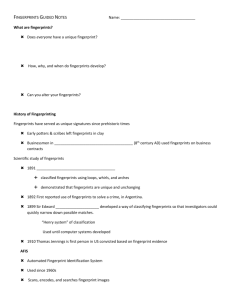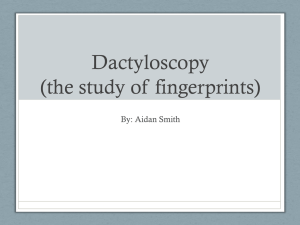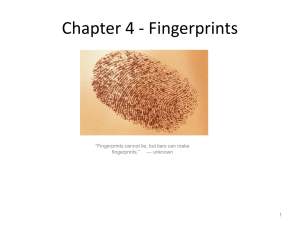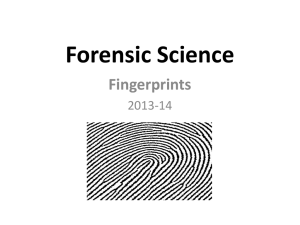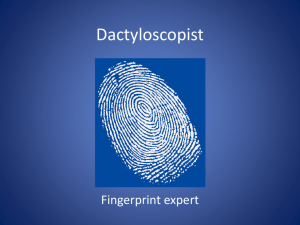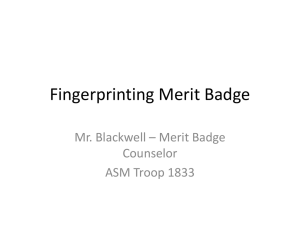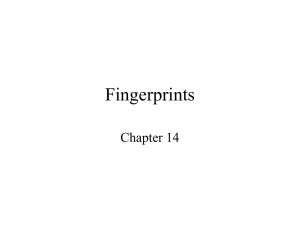Chapter 4 Fingerprints
advertisement
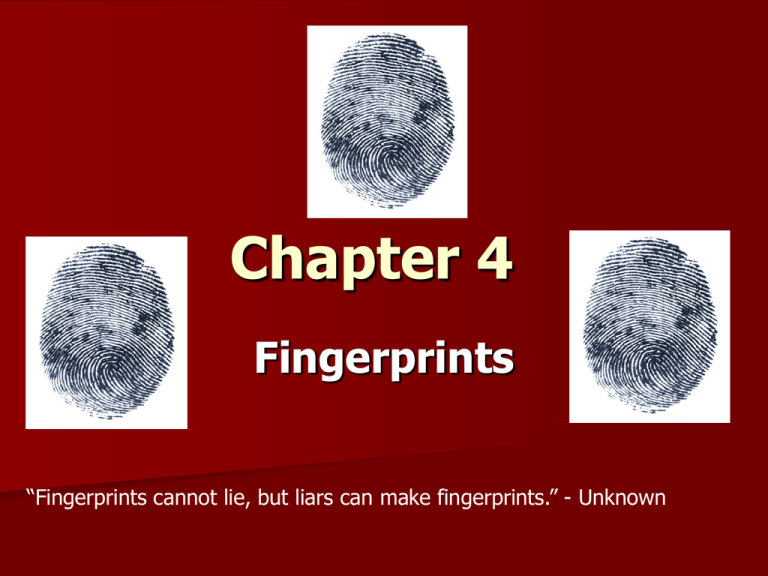
Chapter 4 Fingerprints “Fingerprints cannot lie, but liars can make fingerprints.” - Unknown Objectives Learning Targets: 1) Define the 3 basic properties that allow identification by fingerprints. 2) Recognize the general ridge patterns and apply them to the primary Henry – FBI classification. At the Crime Scene 1) What is a fingerprint? Fingerprint – impression of the pattern of ridges on the last joint of a person’s finger. At the Crime Scene 2) What are the properties of a fingerprint? – Unique ridges. – Consistent over an individual’s lifetime. – Systematic classification used for fingerprints. Classification of Fingerprints 3) How are fingerprints classified? - 3 basic patterns a) loops b) whorls c) arches Classification of Fingerprints 4) What are loops? Loops – The loop pattern has one or more ridges entering from one side, curving, then going out from the same side it entered. All loops have a: – Delta – a triangular area usually shaped like the silt formation near the mouth of a river flowing into the sea. – Core – Near the center of the pattern. Classification of Fingerprints 5) What are whorls? Whorls – ALL whorls must have at least 2 deltas and a core 4 whorl groups: – – – – Plain Whorl Central Pocket Double Accidental Classification of Fingerprints 6) What are arches? Arches – friction ridges enter from 1 side of the finger and exit the other side while rising upward in the middle Arches do not have a delta or core. 2 types – Plain Arches – Tented Arches Classification of Fingerprints 7) What is FBI method of classification? Henry – FBI classification – allows all 10 fingerprint types in the world to be divided into common groups. - IMPORTANT: When prints are sent to the FBI, the Henry-FBI classification system allows for the elimination of millions of prints SO that they only have to hand compare a dozen prints. Ridge Classification 8) What are minutiae? Minutiae – fine structure of ridge characteristics pg 57 in your book for different types Presenting Fingerprints as Evidence 9) How are fingerprints used in court? No legal requirements in US on # of points that match Criminal courts usually accept 8-12 points Challenge: 150-200 minutiae in a properly rolled fingerprint, the problem is getting a good, readable print to work with. Presenting Fingerprints as Evidence 10) What can affect fingerprints? Certain professions can affect a fingerprint – Ex. Concrete workers fingerprints become indistinct over time because alkalinity of cement and gypsum can dissolve proteins. John Dillinger (Public Enemy # 1 in 1930) – paid a doctor $5000to dissolve his fingerprints & perform facial surgery Types of Prints 11) What are the 3 types of prints? Plastic prints – indented/molded prints – press a finger into a plastic-like material (i.e. paint, putty, soap) Visible prints – left by a finger that has touched, colored material such as blood, paint, ink, etc. Latent prints – essentially invisible & must be developed by chemical/physical means – left by deposits of body oils & perspiration Visualizing Latent Prints 12) How are prints developed? Dusting – dusting print with a fine powder Chemical methods – chemicals (i.e. iodine, ninhydrin) generally effective for soft, porous surfaces as paper The History of Fingerprints 13) When did dactyloscopy begin? Dactyloscopy – study of fingerprints Started in 19th century in India with William Herschel Other Methods 14) What computer program does the FBI use to identify fingerprints? Automated Fingerprint Identification Systems (AFIS)



